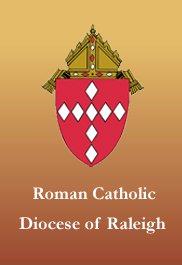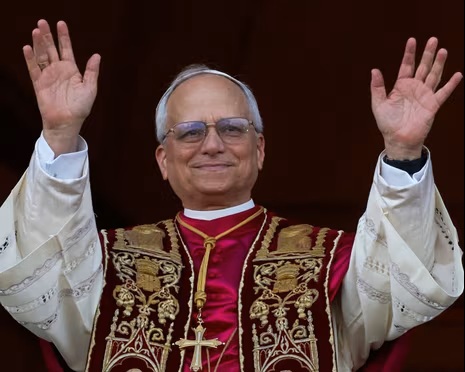Christ at the Center: Connecticut Church Gives Pride of Place to the Eucharist
History was made this year during a church renovation. Renowned architect Duncan Stroik noted that the retablo gracing the sanctuary behind the altar in St. Catherine of Siena Church “is the first new limestone retablo in 60 years” to be installed in a church in the United States. Carved of Indiana limestone, the 17-ton ornamental retablo, or reredos, is the centerpiece of the renovation to put “Christ at the center” of this Trumbull, Connecticut, church.
In front of this retablo masterpiece stands the new altar. For Father Joseph Marcello, the pastor, the inspiration sprang from one of his favorite churches in Rome, the Basilica of St. Mary Major and its Pauline Chapel, home of the shrine of Salus Populi Romani — Mary, Protectress of the Roman People.
The major renovation, which Stroik designed in collaboration with Father Marcello, began with the goal of putting “Christ at the center” of the sanctuary. In a 1997 renovation, the tabernacle had been moved to a side chapel which had been added to the church proper.
Stroik said it was key to return the Eucharist to its proper place. “The most important place is the sanctuary, the place of the altar, the Blessed Sacrament. That was crucial.” That’s precisely what Father Marcello told parishioners: “The tabernacle and altar are the genesis of all the design. We wanted to provide a design that put Christ in the center.”
Pastor and architect worked together on the overall design that included side shrines, repurposing the side chapel with liturgical significance, and making connections to saints and ancient churches in Italy.
The project was announced on the Solemnity of the Assumption 2017. Following a year of planning, construction began in August 2018 and was completed in March 2019. The project was entirely funded by legacy gifts: One family gave the altar, another family gave the St. Joseph Shrine, and another gave the tabernacle, etc. All legacy gifts will be recorded on a large bronze plaque that will be permanently installed in the narthex this year.
According to Stroik, the completed project reflects as much on the pastor’s vision as it does on the deep riches of ecclesial art.
“Father Marcello is a priest who is passionate about art and architecture,” Stroik told the Register. “He’s very knowledgeable. He had huge amounts of input into the design and ideas about what everything symbolized and how everything can be put brought together” for this church to symbolize the Church. Past and present are tied together because the pastor “wanted to reuse some of the artwork the church had” through polychroming and setting the art in new contexts “to beautify them, make them more prominent.”
Start With the Sanctuary
The altar of rich cream-colored botticino classico marble from Brescia and golden marble from Verona reflects European influence. Behind the front’s ornate bronze grillwork, the lighted center contains a relic of St. Catherine of Siena, the church’s patroness, surrounded by lilies in a custom-made sunburst reliquary held up by two golden angels. Beneath the reliquary is a small marble sepulcher holding the relics of more saints, including Eugenius, Candidus, Jean Vianney, Pius X, Elizabeth Ann Seton, Andre Bessette, Francis Xavier Cabrini, and soon-to-be-saint Blessed John Henry Newman.
Stroik noted this type of altar is seen in Europe, including at St. Peter’s Basilica in Rome. On St. Catherine’s feast day or different occasions, her relic can be removed and placed on top of the altar for people to venerate. “It really is making a connection between the bodies of the saints under the altar and the sacrament on top of the altar,” he explained. The brass doors are lockable.
Father Marcello pointed out a special parish connection. The altar was completed in the church this year on Feb. 11, the memorial of Our Lady of Lourdes and the 64th anniversary of the establishment of this parish in 1955. Named pastor in 2015, Father Marcello himself grew up at St. Catherine’s, starting as a kindergartner at the parish school.
Behind the altar, atop a new pedestal of the same marbles, is the new one-ton tabernacle of solid Italian white marble. Looking like a church in miniature, with lines echoing parts of the new retablo, the tabernacle’s eight pilasters are carved of deep-blue lapis lazuli from Afghanistan. Father Marcello said lapis lazuli makes the pigment for the celestial blue in Fra Angelico’s paintings and was used for the ceiling of the Church of Santa Maria sopra Minerva in Rome, where St. Catherine and Fra Angelico are buried.

Above the tabernacle doors, which were part of the original tabernacle, is “a replica of a medallion of the Holy Name of Jesus, which St. Bernadine of Siena placed above the main doors of the cathedral of Siena, birthplace of our patroness.”
Harmonious Connections
The renovation has the distinct quality of being so well integrated into the original church structure that it looks as if it has always been there. The Norman-Gothic church had only a simple limestone triumphal arch across the sanctuary — and this became Stroik’s starting place. Designing the new retablo, Stroik connected to this 1950s Gothic arch.
Father Marcello pointed out the retablo’s columns are named for the Four Evangelists, and the Corinthian capitals “signify the earliest reference to the Eucharist in St. Paul’s First Letter to the Corinthians.”
Many other references in the architecture of the renovation reflect on the Eucharist. A subtle one focuses on the crucifix framed within the retablo’s arch. The background of the same golden marble used for the altar connects both. The original corpus is now on a new African mahogany cross. The cream-colored marble at all four points reflects the altar and “connects Christ’s death with the sacrifice on the altar,” said Father Marcello.
The Titulus Crucis proclaiming, “Jesus of Nazareth, King of the Jews,” has text fully written in Latin, Hebrew and Greek, “to be as close to the original as possible,” the pastor pointed out. Carved in Italy, “It’s a replica of what’s said to be the extant piece of the original now at the Basilica of Santa Croce in Rome.”
The church’s original Holy Spirit image is repositioned high above the crucifix, with 40 new golden sunburst rays signifying his glory.
Images of Sts. Catherine of Siena and John Vianney stand on both sides of the retablo. Both depictions look as if they were made by the same carver, yet St. John Vianney was newly carved in Italy while St. Catherine is original to the church but polychromed to match her counterpart. St. John Vianney’s outstretched arm purposely points to the tabernacle. When the church hosted the “Heart of a Priest” tour recently, allowing the faithful to venerate the saint’s priestly heart, Father Marcello touched John Vianney’s heart to the statue, making it a third-class relic.
Father Marcello sees the new sanctuary as “really a ‘game changer’” for the parish. “In it we are able to prayerfully and meaningfully give worship and thanksgiving to God, even as he strengthens us to go out and better serve him in those who are most in need.”
“Duncan designed the shrines to complement the retablo,” explained the pastor, referring to the new side shrines dedicated to the Blessed Mother and St. Joseph. Other than the wainscoting in the sanctuary, they account for another 3 tons of matching carved Indiana limestone. The restored original statues, now polychromed, stand before a golden marble background framed by iconic columns. Mary’s shrine includes a rondel with a rose that “reflects one of Mary’s titles in the Litany of Loreto, Mystical Rose,” said Father Marcello, “and also reflects one of the titles of St. Catherine, which is Rose of Patience.” The rondel in St. Joseph’s Shrine displays a carpenter’s square with three nails representing the Holy Family.

The harmony of old and new continues in a new ambo of the same cream and golden marbles. Another innovative connection comes with the original Stations of the Cross. Their new oak frames are enlarged to hold new reflections on each station written by Blessed John Henry Newman and refer back to the altar because of his relic being among those encased there.
Holy History
When it was to be built, Bishop Lawrence Shehan, first bishop of the newly erected Diocese of Bridgeport (1953), asked the world-renowned Catholic apologist and radio and TV star at the time, Bishop Fulton Sheen, to offer a benefit lecture at the parish to raise money for the building fund. Venerable Fulton Sheen did, raising much money, and donated his honorarium to the project, too.
At the time, Bridgeport’s bishop and the church’s first pastor designated the sanctuary as a gift of Bishop Sheen. Father Marcello plans to install a plaque to commemorate Bishop Sheen’s gift.
The addition that formerly housed the tabernacle has also been transformed by the renovation. “We repurposed the chapel in a beautiful and meaningful way,” Father Marcello said, as the Memorial Chapel of the Sacred Heart to remember those in the parish who have died.
Above its altar, resting on Alpha and Omega pillars, stands the church’s newly polychromed original statue of the Sacred Heart. Symbols of Mary’s Immaculate Heart and St. Joseph’s Chaste Heart flank Jesus. New murals on either side of Jesus depict Angels of the Passion after Bernini’s angels on the Ponte Sant’Angelo. One offers a miniature St. Catherine’s church to Jesus. The other holds instruments of the Passion, including three dice whose numbers are 3-2-4, which, Father Marcello noted, reflect the date the church was consecrated this year — March 24.

The chapel also has a replica of the mosaic Mater Ecclesia (“Mother Church”) which St. John Paul II had put in St. Peter’s Square. St. Catherine’s reproduction was recently fabricated by Vatican mosaic artisans, and within the church it connects to a pro-life memorial of children lost in miscarriage, stillbirth and abortion.

Stroik believes one of the joys of a Catholic architect is doing such work “that’s part of the local scene but also doing it in a way that’s universal, connecting us to the Roman Catholic Church in all its glory and all its richness.”
Parishioner Patti Pavia already feels this connection. “The beautification of St. Catherine of Siena Church satisfies a deep yearning in my heart to know and understand the traditions of the Catholic Church,” she told the Register. “Moving Jesus and his tabernacle back to the center of the sanctuary would have been enough for me to be grateful. But what Father Marcello has done, with the incorporation of Church history, tradition and ceremony, has brought me to a place of greater awareness and appreciation.”
She concluded, “If wood, stone and steel can be transformed into this beautiful dwelling place for our Savior, I must allow the Lord to transform my heart of flesh and blood into a fitting dwelling place for him, as well.”



